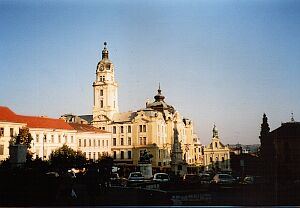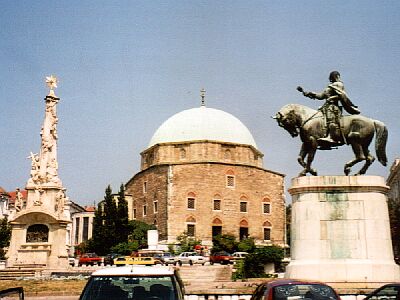Official Name
Pécs (pronounced "pairch"!). The German name of the town is completely different: Fünfkirchen, which means 'five churches'. During the Roman era, the place was known as Sophianae. Later, it was renamed Cinque Ecclesiae (yes, this means 'five churches' as well!). The Ottomans called the place Pecavi, so the recent names obviously derives from the Turkish word.
Location

| ||
| Pecs |
Pécs lies in the heart of Southern Transdanubia, which is a mostly flat and warmer-than-average region in the south-west corner of Hungary. Pécs is located between the river Danube and its tributary, the river Dráva. The town is only a few kilometres away from the forested Mecsek Hill Chain. The border to →Croatia is only 35 kilometres away; →Lake Balaton in the North is around 80 km away.
Population
Around 170,000 - one of the biggest cities of the country.
Orientation
Pécs offers an almost rectangular and well-preserved old town centre, with parts of the old city well remaining impact in the northern and western part of the city. The old town is dominated by the large Basilica of St Peter in the north-west corner in the old town. The absolute centre of town is the wide Széchenyi tér (tér = square), where almost a dozen of streets end - one of them is the pedestrian zone Király utca. The tourist information can be found at the south-west corner of the square. The train and bus station are a 15 minutes walk away from the city centre. To get to the station, walk down Jókai Mór utca southwards from Széchenyi tér. The historically most interesting part of Pécs stretches between the central square and the above-mentioned basilica. The centre itself is rather hilly. The biggest part of the new town stretches to the west.

| ||
| Széchenyi tér, the central square of Pécs |
History
Pécs is an old city. In Roman times, the town was the capital of the province Lower Pannonia. Later on it became something like a religious centre. Because of that, five churches, giving the town its old name, were built. After the foundation of the →First Hungarian Empire, Pecs was chosen for the bishop's residence. In the middle of the 14th century, the first Hungarian university was found here.
After the devastating Mongolian invasion in 1241, city walls were erected and so the town was fortified. This didn't help when the Ottoman Empire advanced. They conquered the town in 1543 and stayed for almost 150 years. The Ottomans applied their own urban planning, and so Pécs today is the one and only Hungarian town with a certain oriental atmosphere. Additonally, Pécs is an important university town.
Getting there / transportation
Around 10 trains a day connect Pécs with the capital →Budapest. But there are no direct trains to the east, and so it's better to catch a bus when going to →Szeged or further. This takes around 3 hrs, the fare is 1,880 ft. There's also one daily direct train to →Osijek in Eastern Slavonia (→Croatia). However, it's an incredibly slow train. The fare from Osijek to Pecs is 94 Kuna (around € 13).
The train service between Budapest and →Sarajevo has been resumed in the year 2002. This train stops in Pecs as well. It leaves 20:42 and arrives in Sarajevo the next day at 05:43. Departure and arrival time are of course subject to change.
The first thing visitors will notice at the central square Széchenyi tér is the so-called Mosque Church. The name already tells the story: Once, the building was used as the Gazi Kassim Pasha Mosque - it's nothing less than the largest preserved building left from the Ottoman occupation in Hungary. After the withdrawal of the Ottoman Empire, the mosque was transformed into a church without destroying the Islamic elements. The dome-shaped roof makes it the most characteristic building at the square.

| ||
| Mosque Church and Holy Trinity Column at Széchenyi square |
Right behind the Mosque Church stands the Archeological Museum. On the central square you will also find the statue of a horseman and next to it the Holy Trinity Column.
When walking north from the square, you will enter a network of small lanes, which are closed to traffic. One of them is called Káptalan utca, where several museums line up.

| ||
| Four-towered Basilica of St Peter |
At the end of the street and thanks to its dimension impossible to miss stands the Basilica of St. Peter with its four towers. Originally built during the 11th century, the church was often destroyed and rebuilt. Most parts of the basilica as it can be seen today date back to the year 1881. The church is almost completely surrounded by the remainings of the old town wall - among them the so-called Barbikan (a similar structure with almost the same name can be found in →Warsaw) marks the oldest part of the fortification system. The Bishop's Palace from the year 1770 stands next to the basilica.
When you walk down the stairs from the basilica, you will get to Szent István tér, a square which should be rather called a park. In the middle of the park, an early Christian chapel has been excavated. The tiny underground chapel is very narrow and features highly interesting frescoes from the 4th century (!)
Besides the Mosque Church in the centre you will find many other buildings being left from the Ottoman occupation. Among them, the Hassan Jakovali Mosque in front of the city wall in the south-west as well as the ruins of an old Turkish Bath (Pascha Memi) are worth mentioning. Religious diversity is not limited to mosques and churches - there's also a large synagogue from the 19th century.
There's much more to see in town. There are many historical buildings, but Pécs has more to offer: It's a vibrant university town, and the size is just perfect for a beautiful walk. This town is definitely my favourite place in Hungary...
South of Pécs there are several thermal springs, most of them concentrating around Harkány not far from the Croatian border. If you have much time to spare, you can also hike to the green Mecsek hill. The second highest hill? mountain? in that area is the 534 m high Misina, featuring an almost 200 metre high TV tower. It's a real landmark.
The tourist information at Széchenyi tér offers private accommodation for 4,000 ft (€ 16) for a double. But it doesn't seem to work every time - we hadn't had a good map to find the place, so when we finally arrived, the room was already given away to another one (we were 15 minutes late!) The owner of the apartment eventually sent us to a friend of her, and so we stayed with a very old lady living in the suburbs...still, private rooms are the best option.
- www.pecs.hu Offical website of Pécs in Hungarian and English. Useful.
- www.visitors.hu/06_04_en.html Many beautiful pictures and a lot of information about Pécs.
Do you have or do you know a good website about Pécs? Don't hesitate, let me know! After checking it, I would love to add it to the link list. You can submit a link by using the →contact form. Note that commercial websites will be treated differently.
©2024 Europe-East.com

 Albania
Albania Hungary
Hungary